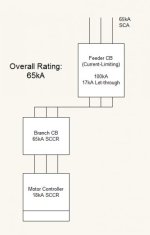kamenges
Member
I generally design around using current limiting fuses in all the power circuits in the control panels I design. However, a recent customer asked that we use circuit breakers instead of fuses. The one concession was that we could use a Class J fuse at the disconnect, which then became the circuit feeder fuse.
The problem I ran into when calculating short circuit current rating (SCCR) for the enclosure was with the branch circuit breakers. According to UL508A supplement B 4.3.3(b), I need to use the lowest interrupt rating of the branch circuit overcurrent protection devices as the SCCR for the enclosure. This is in spite of the fact that the peak let-through current of the feeder Class J fuse is much less than the branch circuit protection interrupt rating at the available fault current at the plant. So instead of being able to rate the enclosure at 65kA SCCR and be well over the available fault current I need to rate it at 10kA, which is less than the available fault current.
Can anyone give me anything approaching a reasonable design rationale why branch circuit protection devices are treated differently than other components relative to the feeders fuses current limiting capability? It doesn't make sense to me. Either the current limiting fuse limits the current to stated levels or it doesn't. If it does then why can't I use that capability relative to the interrupt rating of another fuse or circuit breaker downstream of it?
Keith
The problem I ran into when calculating short circuit current rating (SCCR) for the enclosure was with the branch circuit breakers. According to UL508A supplement B 4.3.3(b), I need to use the lowest interrupt rating of the branch circuit overcurrent protection devices as the SCCR for the enclosure. This is in spite of the fact that the peak let-through current of the feeder Class J fuse is much less than the branch circuit protection interrupt rating at the available fault current at the plant. So instead of being able to rate the enclosure at 65kA SCCR and be well over the available fault current I need to rate it at 10kA, which is less than the available fault current.
Can anyone give me anything approaching a reasonable design rationale why branch circuit protection devices are treated differently than other components relative to the feeders fuses current limiting capability? It doesn't make sense to me. Either the current limiting fuse limits the current to stated levels or it doesn't. If it does then why can't I use that capability relative to the interrupt rating of another fuse or circuit breaker downstream of it?
Keith







